Best gaming monitors: the top 144Hz, 240Hz and 4K monitors
All the best monitors for gaming, including budget, HDR, and ultrawide displays
It’s easy to think of the best gaming monitors as an extravagance – surely everything your games need for a smooth ride is within the PC itself, and any old screen will do the trick? Not so. It’s true that even the most opulently-specced monitor won’t technically make your games run faster, but they can make them look better, whether it’s by unlocking slicker framerates with a high refresh rate, letting colours bloom brigher, or eliminating ugly tearing effects with FreeSync and G-Sync. A proper gaming monitor, then, is a more than worthy addition to your desk, and these here are the best ones we’ve tested.
As with all our top hardware guides, there’s something for everyone here. On a tight budget? You can still nab yourself a quality 1080p monitor. Or, if you’re looking to get the most out of a powerful graphics card, a sharper 1440p display may be the one for you. We have a separate guide to the best 4K gaming monitors, but you’ll also find a few highlights in this list, in case you want the very finest, sharpest screen for your high-end rig. We’ve tested all of them in the same way: regular games-playing, combined with more technical recordings of colour, contrast and brightness performance.
There’s also a growing selection of ultrawide gaming monitors, which can add a striking wraparound effect that’s especially suited for sims. Just keep in mind that as with 4K and, to a lesser extent, 1440p monitors, ultrawide models will put extra strain on your GPU by virtue of having so many pixels to fill out. Make sure your PC comes adequately equipped for such hefty displays, and make use of performance-saving upscalers like DLSS and FSR when you can.
Now, about those monitor picks...
Best gaming monitors
- AOC 24G2U - the best 1080p gaming monitor
- Iiyama G-Master G2755HSU - the best cheap 1080p gaming monitor
- Lenovo Legion Y25-30 - the best 240Hz gaming monitor
- NZXT Canvas 27Q - the best 1440p gaming monitor
- AOC CQ32G3SU/BK - the best large 16:9 gaming monitor
- Lenovo Legion R45w-30 - the best ultrawide gaming monitor
- BenQ Mobiuz EX3410R - the best cheap ultrawide gaming monitor
- Corsair Xeneon 32UHD144 - the best 4K gaming monitor
- MSI MAG 274UPF - the best value 4K gaming monitor
- Asus ROG Swift PG32UQX - the best 4K HDR gaming monitor
AOC 24G2U
The best 1080p gaming monitor
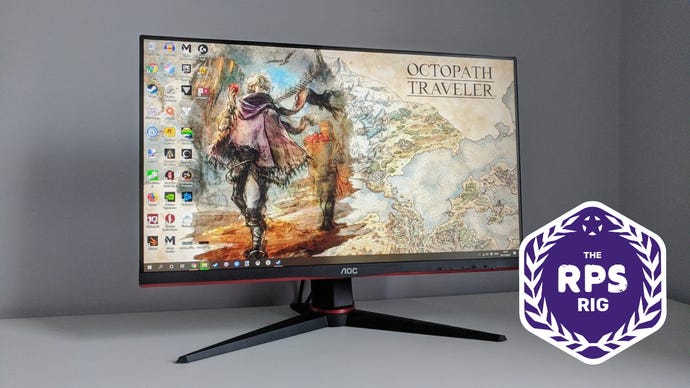
The AOC 24G2U is hands down one of the best gaming monitors around. Its accessible price makes it a great budget gaming monitor, and its high refresh rate gives it plenty of headroom for both low and higher-end graphics cards alike. That's why it's currently our number one recommendation in our £1,000 PC build, the RPS Rig, as well as an ideal upgrade for anyone upgrading from an old or basic desktop display.
It's not one of Nvidia's officially certified G-Sync Compatible screens, all told, but our tests showed its adaptive sync support works just as well with Nvidia graphics cards as it does with AMD ones when using the officially-supported FreeSync. It's infinitely better than AOC's other similarly priced gaming monitor, the AOC G2590FX, both in terms of colour accuracy and overall contrast, and it's also better value for money than the very similar and slightly more expensive Viewsonic Elite XG240R.
The AOC 24G2U has an excellent 24in screen, and its fantastic IPS panel covers 99.6% of the standard sRGB colour gamut straight out of the box, meaning you don't have to spend ages tweaking anything to get a great picture. That's a lot for a monitor of this size and price, and it's arguably much better value for money than some of the larger screens further down on this list.
Read more in our AOC 24G2U review
Iiyama G-Master G2755HSU
The best cheap 1080p gaming monitor

Staying thrifty doesn’t have to mean confining yourself to a tiny 60Hz office monitor that thinks adaptive sync is a new type of plumbing fixture. The Iiyama G-Master G2755HSU asks for little and offers much in exchange, from its 100Hz refresh rate – more than enough for a visible smoothness improvement over 60Hz – to a comfortably spacious 27in VA panel. And yes, there’s FreeSync, which turns into G-Sync when connected to an Nvidia GPU.
It is missing some of the trappings that a few extra twenties will buy you, most notably in its lack of stand adjustment. But the screen itself is a great budget performer, with its lofty contrast ratio (3692:1) and rock-bottom black level (0.07cd/m2, the closer to 0 the better). Although it does exhibit a dash of the ghosting that’s common on VA monitors, I never felt I was having to squint through it when playing games, shooters included. Between the upped refresh rate and improvised G-Sync, it usually looks nice and smooth. It’s not short on vibrancy either, covering 97.6% of the sRGB colour gamut, and at a 263.9cd/m2 peak, brightness is high for a cheap gaming monitor.
Lenovo Legion Y25-30
The best 240Hz gaming monitor
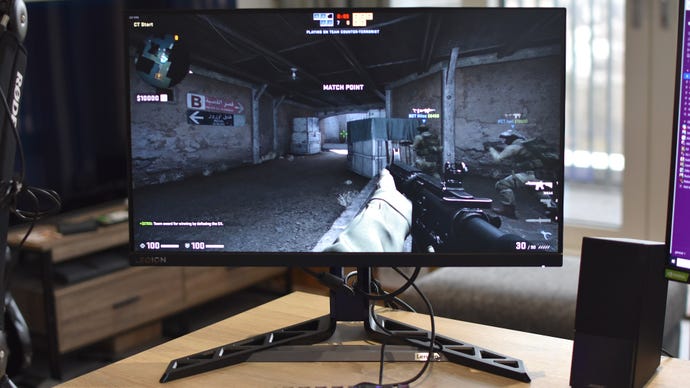
A lot of 240Hz monitors – that is, monitors that can refresh their image 240 times a second – are simply not worth their inflated price. The Lenovo Legion Y25-30, by contrast, makes a compelling case for itself. The IPS panel, while only 1080p, delivers brilliantly rich colours, and its non-HDR peak brightness of 363cd/m2 keeps them popping. In games that support HDR, that can rise up to 467cd/m2: more than enough to shine.
You get plenty else for your money, including a fully adjustable (if plasticky) stand and an onboard USB hub. And, of course, the 240Hz refresh rate is excellent for racing games and competitive shooters. It’s true that most other games won’t benefit as much, making the Legion Y25-30 more of a specialist monitor, but don’t entirely believe the framerate Luddites: 240fps does look smoother than 144fps. Sorry. It just does.
The real problem is getting that high, as you’ll need a very powerful GPU indeed to produce enough frames that the Legion Y25-30 can take full advantage of them. Tick that box, though, and it’s a strong niche-filler.
NZXT Canvas 27Q
The best 1440p gaming monitor
Seemingly not content with successful debuts in the gaming keyboard and USB microphone arenas, NZXT have launched a brilliant new 1440p gaming monitor as well. The NZXT Canvas 27Q is a sharp and vivid IPS monitor that, between its 165Hz refresh rate and generally strong motion handling, presents a match for far more experienced monitor makers on gaming performance.
You could argue it looks basic with the default stand, but I’d rather have a clean, mature design over something that screams “Aaaaaargh look here I’m a gamer wot plays games.” It’s a good stand, too: strong and steady, with the full set of height, tilt and rotation adjustment capabilities. The rear OSD joystick also feels a tad bigger than average, so it’s easy to use when you want to make display adjustments.
Not that many are necessary. In its “Standard” image profile, the Canvas 27Q covers 99.5% of the sRGB gamut, with a good peak brightness of 382cd/m2 and a 1058:1 contrast ratio. Every game I ran on this display looked smooth and sumptuous, and it all comes at a surprisingly competitive price.
The only drawbacks are twofold: one, it’s not quite bright enough for HDR games, and two, the optional monitor arm makes for a far less affordable package. I found the arm itself quite well-made, and it has all the usual space-saving and adjustability advantages over the regular stand, so I’d love to recommend it as well. For an extra £100 / $60, though? Maybe not.
AOC CQ32G3SU/BK
The best large 16:9 gaming monitor
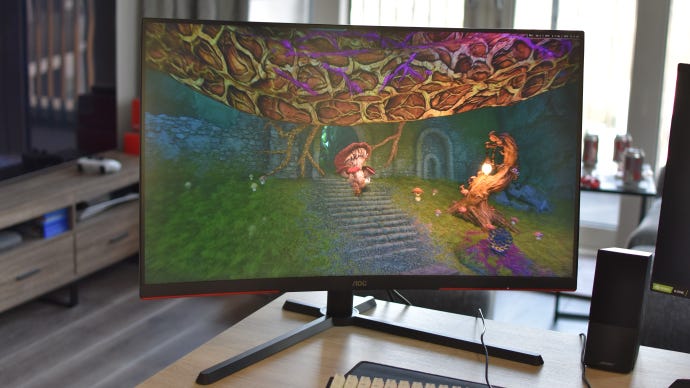
Most gaming monitors come in under 30in diagonally, though some can go bigger – without splaying all the way out into ultrawide dimensions. The AOC CQ32G3SU/BK is my current favourite of these oversized 16:9 models, its 1440p resolution being high enough to keep games and desktop apps looking sharp despite the lower pixel density that comes with a bigger panel.
Speaking of panels, this one is curved, which makes keeping the corners in view a little more comfortable. Otherwise, this a no-frills yet always competent gaming monitor, reaching all the way up to 165Hz for lusciously slick views on suitably powerful setups. As with a lot of VA monitors, there is a bit of ghosting visible on fast-moving objects, but setting pixel overdrive to its Medium setting helps tone this down (without overshooting and adding reverse ghosting). The upside of a VA panel is some excellent contrast, which I measured at 2514:1, and colours have a nicely natural look: not too bland, not too oversaturated.
Lenovo Legion R45w-30
The best ultrawide gaming monitor

Hey, if you’re going to go wide, you might as well go reeeeeeeeally wide. The Lenovo Legion R45w-30’s 5120x1440 resolution makes for an aspect ratio of 32:9, basically the most stretched-out that games will commonly support. That’s as many pixels as two standard widescreen 1440p monitors glued together.
Assuming you’ve got a PC that can handle the load – and a desk that can handle that gigantic stand – it delivers on games performance too. High contrast and deep blacks maintain detail in dark scenes, and while there’s the tiniest smidge of ghosting on fast-moving objects, it’s actually quite clean for a VA panel. With FreeSync/G-Sync in action especially so. There’s plenty of colour – the R45w-30 covers a full 100% of the sRGB gamut – and brightness is high enough for basic HDR, peaking at 426cd/m2.
It's also rather well-priced for the specs. I’ve seen curved 5120x1440 monitors regularly starting above £1000, so while this is far from the cheapest ultrawide gaming monitor around, it’s still a very, very good deal.
BenQ Mobiuz EX3410R
The best cheap ultrawide gaming monitor
Only recently a true mid-ranger, sustained price cuts have brought the BenQ Mobiuz EX3410R into the ultrawide equivalent of budget territory. Which is excellent, as it’s still a cracking 21:9 screen. I have one myself!
It uses a curved VA panel, which often have more trouble with motion than IPS or TN screens, but some spot-on pixel overdrive saves it from any noticeable blurriness. Between this, a low G2G response time of 2ms, and the 144Hz refresh rate, the Mobiuz EX3410R is as agile as it is expansive. FreeSync Premium Pro helps as well, and Nvidia G-Sync is effective at denying screen tear while piggybacking on it.
With the sRGB colour profile, the Mobiuz EX3410R has a neutral, nicely balanced colour palette – one that covers 96.7% of the sRGB gamut and hits a super-accurate 1.08 average delta-E. Contrast is good too, reaching 3093:1, and peak non-HDR brightness is decent at 391.1cd/m2. This monitor is only rated at the most basic DisplayHDR 400 standard of high dynamic range capability, but if you do prefer a bit of pop, to more natural tones, turning HDR on does produce some richly vibrant hues in the games that support it.
If you can splash out even more, we'll also recommend the sprawling, 49in Samsung CRG9 and its curved QLED panel.
Corsair Xeneon 32UHD144
The best 4K gaming monitor
The Corsair Xeneon 32UHD144 manages to evoke a similar "Wow, that’s pretty" response to the Asus ROG Swift PG32UQX below, just at a much lower price. It’s still a premium prospect but its HDR-ready brightness, extremely wide colour reproduction, artifact-free smoothness and high build quality are worth the investment.
Even the Standard colour profile covers a near-perfect 99.8% of the sRGB gamut, and there’s no IPS contrast weakness here, hitting 1019:1. Nvidia G-Sync also works effectively to smother any potential screen tearing, even if it’s FreeSync Premium that get the native support. Provided you have room for the 32in panel and its metal stand, which looks and feels like it previously held up the Schwerer Gustav, it’s the ideal match for any 4K-capable GPU.
MSI MAG 274UPF
The best value 4K gaming monitor
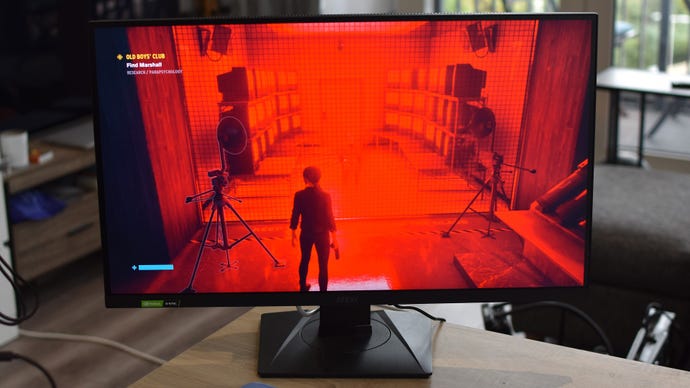
Outside of its mundane design and modestly proportioned 27in IPS panel, there’s little sense that the MSI MAG 274UPF is of the moneysaving persuasion. Yet there aren’t many 4K gaming monitors that, for comparable cash, manage to pile on so many perks: 144Hz, Nvidia-approved G-Sync compatibility on top of FreeSync, USB-C and HDMI 2.1 connectivity, a fully adjustable stand… it even has a fair crack at HDR-grade brightness, peaking at 519cd/m2 in Final Fantasy XV.
That would all be for naught if the screen itself was duff, but it’s free of ghosting, covers 99.3% of the sRGB gamut, and recorded a contrast ratio of 1020:1 in my tests. HDR isn’t needed for high brightness, either, as the MAG 274UPF managed to hit 489cd/m2 in standard dynamic range.
If that all sounds like technononsense, the short version is that games look bright, bold, and smooth, provided they’re running on a PC that can tango with the resolution. Not bad at all, for something that costs hundreds less than the average 4K/144Hz monitor.
Asus ROG Swift PG32UQX
The best 4K HDR gaming monitor
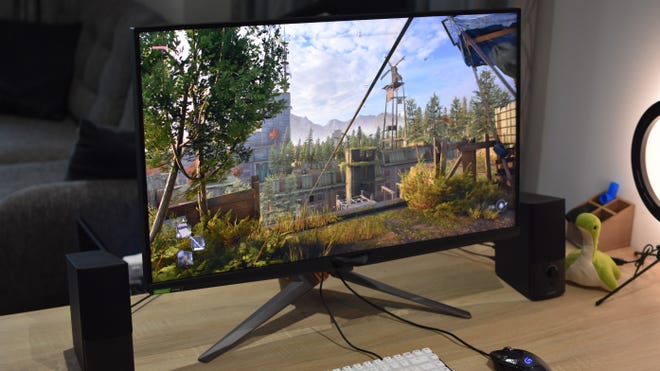
The Asus ROG Swift PG32UQX was the first Mini LED gaming monitor when it launched, and it makes full use of this relatively new backlighting tech to comfortably surpass 1000cdm/2 in HDR-compatible games. Because Mini LED allows for full-array local dimming (FALD), the ROG Swift PG32UQX also benefits from higher contrast and more uniform backlighting than most non-FALD IPS monitors.
It's not all about brightness either: this is as high-spec a monitor as you’ll get from the current generation, marrying a 4K resolution and 144Hz refresh rate for immaculate picture quality on premium GPUs. Colour accuracy is particularly excellent, with the ROG Swift PG32UQX scoring an outstandingly low average delta-E of 1.
None of this comes cheap, admittedly. Mini LED is a very nice upgrade but you’d need to drop big, big money to get it in a monitor that’s as all-round luxurious as this. The Porsche Design AOC Agon Pro PD32M is a much more affordable alternative, though it's not as quasar-bright as the PG32UQX.
Read more in our Asus ROG Swift PG32UQX review
How we test our gaming monitors
When we get a gaming monitor in for testing, we measure the panel's colour accuracy, contrast level, brightness and black level - both Katharine and myself use the X-Rite i1 DisplayPro calibrator for this. We'll start by measuring the default settings that you get out of the box, and then go about optimising it through the monitor's onboard menu system. The best gaming monitors won't need any tweaking at all, as their panels should be configured correctly as soon as you take them out of the box.
HDR monitors require a few more specific tests, namely using specific scenes in Assassin's Creed Odyssey and Final Fantasy XV to measure a monitor's peak brightness level. To do this, the calibrator sits over their bright, in-game suns to see just how high the monitor's brightness levels can go. We also see how easy it is to get a monitor's HDR working and configured correctly. After all, no one wants to spend ages fiddling about with their monitor's menu settings just to get a single game working properly.
In terms of what to expect from different types of of gaming monitor panels, IPS screens usually have the most accurate colours, but there are plenty of good-looking TN and VA panels around now these days as well. TN panels often have quicker response times than other panel types, which can make them a good choice for fast, competitive esports games, but you're vanishingly unlikely to have serious problem playing games on slower IPS or VA panels. We're often only talking about a different of a couple of milliseconds here, and most people won't notice the difference whatsoever.
We also test to see how well a monitor copes with different types of graphics cards if they have AMD Freesync or Nvidia G-Sync support. This is particularly important if they're not one of Nvidia's officially certified G-Sync Compatible monitors. While all Freesync monitors are technically G-Sync compatible (with a small 'c'), some are better suited to it than others. Bad G-Sync compatible screens, for example, can sometimes blink, pulse, produce off-colours or other visual defects, and nobody wants that. If you want to avoid the hassle of potentially going with a small 'c' G-Sync compatible screen, then you can always get one that's been officially certified by Nvidia as big 'C' G-Sync Compatible (and you'll find a complete list linked above on the right).
For more RPS recommended hardware, here's a complete list of our best hardware guides:
Best graphics cards Best CPU for gaming Best SSD for gaming Best gaming headsets Best gaming keyboards Best gaming mouse Best VR headsets









